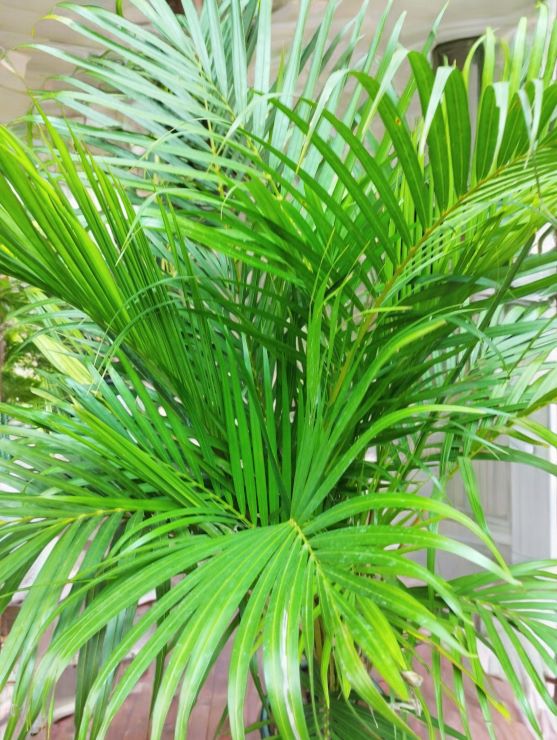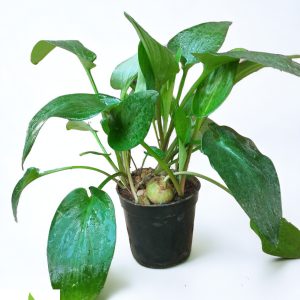Areca Palm – 4 ft
This product is available for shipping only in Bangalore
The Areca Palm (Dypsis lutescens), also known as the Butterfly Palm or Golden Cane Palm, is a popular indoor and outdoor plant known for its graceful appearance and air-purifying qualities. It is often chosen as a decorative plant for homes, offices, and public spaces due to its elegant fronds and tropical vibes.
If you’re looking to add a tropical vibe to your home, nothing beats a palm plant. Though palm trees have limited outdoor ranges, once you look for them, you’ll start noticing areca palms in interiors everywhere, from offices to shopping malls. Areca palms are widely available and easy to grow, and their lush foliage even helps remove some toxins from the air. It’s no wonder they’re popular!
The Areca Palm features multiple slender, arching stems that grow in clusters from the base. The stems are covered with smooth, golden-yellow or light green colored bark, giving it a vibrant and tropical look. The plant can reach a height of around 6 to 10 feet (1.8 to 3 meters) indoors and can grow much taller outdoors in its native habitats.
Plant Height: approx 4 ft including the pot
Pot size : 8 inches nursery pot
- Estimated Delivery : Up to 3 business days
- Free Shipping & Returns : On all orders over ₹550 in Bangalore
Areca Palm (Dypsis lutescens), also known as the Butterfly Palm or Golden Cane Palm, is a popular houseplant and outdoor ornamental plant known for its graceful, arching fronds and clumping growth habit. Native to Madagascar, this tropical palm is prized for its lush, feathery foliage and ability to thrive in indoor environments, making it a common choice for both homes and offices. With proper care, Areca Palms can grow to impressive heights, creating a beautiful, natural screen or focal point in any space. Here’s a comprehensive guide to caring for the Areca Palm:
1. Light Requirements
- Bright, Indirect Light: Areca Palms thrive in bright, indirect light. They do best when placed near a window with filtered sunlight. Direct sunlight can cause the fronds to yellow or burn, especially during the hottest part of the day.
- Tolerates Some Shade: While they prefer bright light, Areca Palms can tolerate some shade. However, too little light can result in slower growth and fewer fronds. If growing indoors, an east or west-facing window is ideal.
2. Watering
- Regular Watering: Areca Palms prefer consistently moist soil, but it’s crucial to avoid overwatering. Water the plant when the top inch of soil feels dry to the touch. Overwatering can lead to root rot, so ensure the pot has good drainage.
- High Humidity: These palms thrive in high humidity environments. In dry indoor conditions, increase humidity by misting the leaves regularly, placing a humidity tray nearby, or using a humidifier.
- Winter Watering: In cooler months, reduce watering frequency as the plant’s growth slows down, but do not let the soil dry out completely.
3. Soil
- Well-Draining Soil: Use a well-draining, aerated potting mix to prevent waterlogging. A mix of peat, perlite, and sand or a palm-specific potting mix is ideal to provide the necessary drainage and aeration.
- Slightly Acidic to Neutral pH: A soil pH range of 6.0 to 7.5 is suitable for Areca Palms.
4. Temperature and Humidity
- Warm Temperatures: Areca Palms prefer temperatures between 65-75°F (18-24°C). They are sensitive to cold and should be protected from temperatures below 50°F (10°C).
- High Humidity: High humidity is essential for maintaining the health of Areca Palms. To increase humidity, mist the leaves regularly or place a humidifier nearby, especially in dry climates or during winter when indoor air can be drier.
5. Fertilizing
- Regular Feeding: Feed Areca Palms every 2-3 months during the growing season (spring and summer) with a balanced, water-soluble fertilizer. A palm-specific fertilizer that includes micronutrients like magnesium and iron is beneficial to prevent yellowing of the fronds.
- Avoid Over-Fertilizing: Too much fertilizer can lead to salt buildup in the soil, which can cause leaf burn. Always follow the recommended dosage and flush the soil periodically to prevent salt accumulation.
6. Pruning and Maintenance
- Remove Dead or Yellowing Fronds: Prune off any dead, yellowing, or brown fronds to maintain the plant’s appearance and encourage healthy new growth. Use clean, sharp scissors or pruners to avoid damaging the plant.
- Trimming for Shape: Avoid excessive pruning, as Areca Palms do not respond well to cutting back. Focus on removing only the dead or damaged fronds.
7. Propagation
- Division: Areca Palms can be propagated through division. When repotting, carefully separate the root ball into smaller sections, ensuring each section has roots and healthy shoots. Plant the divisions in separate pots with fresh potting mix.
- Seeds: Propagation from seeds is possible but is a slower method. Seeds require warm temperatures and consistent moisture to germinate.
8. Pests and Diseases
- Common Pests: Areca Palms can be susceptible to pests such as spider mites, mealybugs, and scale insects. Regularly inspect the plant and treat infestations with insecticidal soap or neem oil.
- Fungal Issues: Overwatering and poor drainage can lead to root rot and fungal diseases. Ensure good air circulation and avoid waterlogging the soil to prevent these issues.
9. Indoor vs. Outdoor Growing
- Indoor Growing: Areca Palms are popular indoor houseplants due to their ability to thrive in indirect light and moderate indoor conditions. They are often used as natural screens or focal points in homes and offices.
- Outdoor Growing: In suitable climates, Areca Palms can be grown outdoors as part of tropical landscaping. They are commonly planted in groups or as standalone specimens to create a lush, tropical ambiance.
10. Toxicity
- Non-Toxic: Areca Palms are non-toxic to pets and humans, making them a safe choice for households with cats, dogs, or children.
11. Container Growing
- Pot Requirements: Choose a large pot with drainage holes to accommodate the plant’s root system and prevent waterlogging. Use a high-quality, well-draining potting mix, and repot every 2-3 years or when the plant becomes root-bound.
- Repotting: Areca Palms should be repotted when they outgrow their current container, usually every couple of years. Fresh potting mix will provide the plant with new nutrients.
12. Overwintering
- Indoor Protection: In colder regions, bring Areca Palms indoors before the first frost. Place them in a bright location with indirect light and maintain humidity levels to keep the plant healthy during the winter months.
By following these care tips, your Areca Palm will thrive, providing a lush, tropical display of greenery that enhances any indoor or outdoor space. Its feathery fronds and elegant form make it a favorite choice for adding natural beauty and a tropical feel to homes, offices, and gardens.
** Plants photos are for representation purpose only. We will make best efforts to send the plants as in photos itself, however it is not always guaranteed as plants might overgrow or shrink depending on the season, care or age. Trust us, we want to give you the best














Reviews
There are no reviews yet.